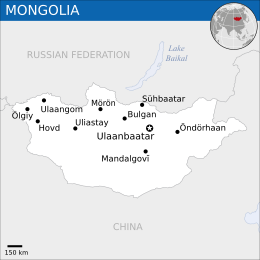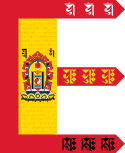Bogd Khanate of Mongolia (1911–1924): Difference between revisions
Tag: Visual edit |
No edit summary Tag: Visual edit |
||
| Line 1: | Line 1: | ||
{{Infobox country|name=Bogd Khanate of Mongolia|native_name=ᠪᠣᠭᠳᠠ ᠬᠠᠭᠠᠨᠲᠤ ᠮᠣᠩᠭᠣᠯ ᠤᠯᠤᠰ<br>Богд хаант Монгол Улс|image_flag=Flag of Bogd Khanate.svg|image_coat=Bogd Khanate Emblem.svg|capital=Niislel Khüree|mode_of_production=[[Feudalism]]|government_type=[[Theocratic]] [[monarchy]]|leader_title1=Khan|leader_name1=[[Bogd Khan]]|life_span=1911–1924|image_map=Mongolia map.svg|map_width=260|common_languages=Mongolian}} | {{Infobox country|name=Bogd Khanate of Mongolia|native_name=ᠪᠣᠭᠳᠠ ᠬᠠᠭᠠᠨᠲᠤ ᠮᠣᠩᠭᠣᠯ ᠤᠯᠤᠰ<br>Богд хаант Монгол Улс|image_flag=Flag of Bogd Khanate.svg|image_coat=Bogd Khanate Emblem.svg|capital=Niislel Khüree|mode_of_production=[[Feudalism]]|government_type=[[Theocratic]] [[monarchy]]|leader_title1=Khan|leader_name1=[[Bogd Khan]]|life_span=1911–1924|image_map=Mongolia map.svg|map_width=260|common_languages=Mongolian}} | ||
The | The '''Bogd''' '''Khanate of Mongolia''' was a [[Theocracy|theocratic]] [[Feudalism|feudal]] state that existed between the [[Mongolian Revolution of 1911|1911 national liberation revolution]] and the [[Mongolian People's Revolution|1921 socialist revolution]] in Mongolia. | ||
== History == | == History == | ||
| Line 28: | Line 28: | ||
The Bogd Khan gave power to Chinese warlords led by [[Chen Yi]] in 1919 and continued to receive a large salary for himself and his wife. Mongolian feudal lords were still able to exploit the peasants without interference. In November 1919, the [[Xu Shichang|Chinese president]] abolished the autonomy of Outer Mongolia. China forced the Mongolian peasants to pay for its military and for all losses caused to Chinese companies after independence in 1911.<ref name=":03" /><sup>:275–7</sup> | The Bogd Khan gave power to Chinese warlords led by [[Chen Yi]] in 1919 and continued to receive a large salary for himself and his wife. Mongolian feudal lords were still able to exploit the peasants without interference. In November 1919, the [[Xu Shichang|Chinese president]] abolished the autonomy of Outer Mongolia. China forced the Mongolian peasants to pay for its military and for all losses caused to Chinese companies after independence in 1911.<ref name=":03" /><sup>:275–7</sup> | ||
In the summer of 1920, the [[United Kingdom of Great Britain and Northern Ireland|UK]] and [[United States of America|USA]]-backed Zhili clique overthrew the Anhui clique. Chen Yi arrived in Mongolia as High Commissioner and arrested and tortured many revolutionaries.<ref name=":03" /><sup>:281–2</sup> | |||
=== Socialist revolution === | |||
{{Main article|Mongolian People's Revolution}} | |||
== Economy == | == Economy == | ||
Revision as of 20:39, 31 May 2024
| Bogd Khanate of Mongolia ᠪᠣᠭᠳᠠ ᠬᠠᠭᠠᠨᠲᠤ ᠮᠣᠩᠭᠣᠯ ᠤᠯᠤᠰ Богд хаант Монгол Улс | |
|---|---|
| 1911–1924 | |
 | |
| Capital | Niislel Khüree |
| Common languages | Mongolian |
| Dominant mode of production | Feudalism |
| Government | Theocratic monarchy |
• Khan | Bogd Khan |
The Bogd Khanate of Mongolia was a theocratic feudal state that existed between the 1911 national liberation revolution and the 1921 socialist revolution in Mongolia.
History
Background
Following the 1904–5 Russo-Japanese War, Inner Mongolia fell under Japan's sphere of influence while Outer Mongolia fell under Russia's influence. The Russian Empire sought to control Mongolia in order to gain an advantage against imperialist Japan. Between 1891 and 1908, Russian exports to Mongolia increased by 22% while Mongolian exports to Russia increased by 566%.[1]:232–3
In early 1911, Colonel Tan from the declining Qing dynasty arrived in Mongolia and ordered barracks to be built in Örgöö (now Ulaanbaatar). The Mongol nobility held a secret meeting in July planning to break away from the Qing and notified the Russian ambassador to Mongolia. In October, the collapsing Qing agreed not to do any reforms in Outer Mongolia without Russian approval.[1]:234–7
1911 revolution
Mongolia declared independence on 1911 December 1, and the Chinese garrison returned to China under the protection of Russian Cossacks. The Qing official in Khovd sealed himself inside a fort with many soldiers and supplies and requested reinforcements from Xinjiang, which Russia prevented from arriving. On 1912 August 6, the peasants stormed the fortress and destroyed debt records. After the Qing was overthrown, the feudal nobility led by the Bogd Khan took power. Yuan Shikai, the new ruler of China, refused to recognize Mongolia's independence.[1]:237–40
While the revolution freed the peasants (arat) from debt held by Chinese usurers and prevented them from having to fund the Qing garrison, it did not weaken the exploitation by the domestic nobility.[1]:253
Establishment of foreign relations
In 1912 November, Russia signed a treaty with Mongolia giving Russian capitalists unlimited rights to trade and travel in Mongolia with no tariffs. The Bogd Khan sent Tserenchimed to Japan and requested a Japanese protectorate over Mongolia, which Japan refused in order to avoid angering Russia. In 1913 February, Mongolia formed a brigade of the Russian army with 1,900 soldiers. Mongolia tried to establish diplomatic relations with other imperialist countries but failed. Yuan Shikai's forces attacked Mongolia in early 1913 and made peace in November, recognizing Mongolia as autonomous but not fully independent. The Bogd Khan withdrew his troops from Inner Mongolia in 1913, and Russia withdrew its troops from Outer Mongolia in 1914.[1]:240–7
The secular nobility generally favored Russia while the lamas, who formed the Bogd Khan's inner circle, favored Japan. The lamas poisoned the pro-Russian prime minister and foreign minister.[1]:253
Russia stopped exporting to Mongolia during the First World War, and the 1915 Hiagt Agreement allowed Chinese merchants to return to Mongolia.[1]:258
Russian and Chinese invasions
In 1917, peasants in the provinces of Tsetsen Khan and Tushetu Khan protested against feudalism and foreign imperialism but did not achieve anything.[2]:271
In late 1917, fighting broke out near the northern border of Mongolia between workers and peasants and invading Whites and local feudal lords. In early 1918, the capitalists, landlords, kulaks, and Whiteguards who had been overthrown in Russia began fleeing into Mongolia, making the peasants desire a revolution in their own country. When the Whites took control of Siberia in late 1918, Soviet workers and peasants fled to Mongolia. The Bogd Khan allied with the pro-Japanese Anhui clique of Chinese warlords, who invaded Mongolia in 1918. In mid-1919, after retaking the East, the Soviet government abolished all unequal treaties Russia had had with Mongolia. The Khan rejected the Whiteguard Semyonov's plan to unify all Mongol lands into a single state that Japan could control, which collapsed in 1919.[2]:272–5
The Bogd Khan gave power to Chinese warlords led by Chen Yi in 1919 and continued to receive a large salary for himself and his wife. Mongolian feudal lords were still able to exploit the peasants without interference. In November 1919, the Chinese president abolished the autonomy of Outer Mongolia. China forced the Mongolian peasants to pay for its military and for all losses caused to Chinese companies after independence in 1911.[2]:275–7
In the summer of 1920, the UK and USA-backed Zhili clique overthrew the Anhui clique. Chen Yi arrived in Mongolia as High Commissioner and arrested and tortured many revolutionaries.[2]:281–2
Socialist revolution
See main article: Mongolian People's Revolution
Economy
Class structure
Nobles (hoshun dzasak) had absolute power over their serfs, who were divided into three categories: hamjlaga, shav', and albat.[1]:251 The albat were the largest group of serfs and had to serve the nobility with corvée labor and pay them rent in kind. The hamjlaga had to follow their lords everywhere and often did domestic labor. The shavinar were forced to serve the clergy (lam) instead of the other nobles.[3] The number of shavinar increased from 55,479 to 89,362 during the Bogd Khanate, reaching a total of a third of the population.[1]:252
The Bogd Khan confiscated the Qing royalty's herds and gave them to princes and lamas. Many peasants owned no or few livestock and a large proportion were beggars, including a majority in Erdenedalai. Monasteries and princes often owned more livestock than hundreds of peasant families combined.[1]:251–4
State budget
Most of the state budget was spent on the Khan and his court. The Khan restored Yongzheng's payment of fixed salaries to nobles based on rank.[1]:257
Mongolia had a budget deficit because of loans from the Russian Empire. Trade with Russia had no tariffs, and over 70% of the state's budget came from internal customs imposed on transportation of goods between different regions of Mongolia.[1]:257
Government
The Bogd Khanate was an absolute monarchy with the Bogd Khan as head of church and state. In 1914, the Bogd Khan created two houses to advise him, but they had no power to make laws and could be dissolved at will. The upper house was made up of high-ranking feudal lords, and the lower house was made up of low-ranking lords and officials. The nobility and peasants were tried in separate courts as they had been under the Qing.[1]:250–1
Education
The first secular school in Mongolia opened in Örgöö in 1912 with 47 students. The same year, a military school opened in Khurzhir-bulan taught by Russian instructors.[1]:262
An anti-monarchist newspaper was founded in 1915. An official history of Mongolia was released in 1919 in 11 volumes.[1]:263
References
- ↑ 1.00 1.01 1.02 1.03 1.04 1.05 1.06 1.07 1.08 1.09 1.10 1.11 1.12 1.13 1.14 A. A. Guber, et al. (1973). History of the Mongolian People's Republic: 'The National-Liberation Movement of the Mongolian People'.
- ↑ 2.0 2.1 2.2 2.3 A. A. Guber, et al. (1973). History of the Mongolian People's Republic: 'The Mongolian People's Revolution and the Proclamation of the Mongolian People's Republic'.
- ↑ A. A. Guber, et al. (1973). History of the Mongolian People's Republic: 'Mongolia under the Rule of the Manchu Conquerors' (pp. 196–9).

